Solvent extraction lets you draw out delicate fragrances from flowers and plants that wouldn't survive traditional steam distillation. You'll use specialized solvents like hexane, ethanol, or acetone to dissolve the plant's aromatic compounds, creating a concrete that contains essential oils, waxes, and resins. After filtering and processing, you'll get a concentrated absolute with authentic, long-lasting scents. Understanding the details of each extraction method will help you choose the perfect approach for your natural perfume projects.
Understanding the Basics of Solvent Extraction
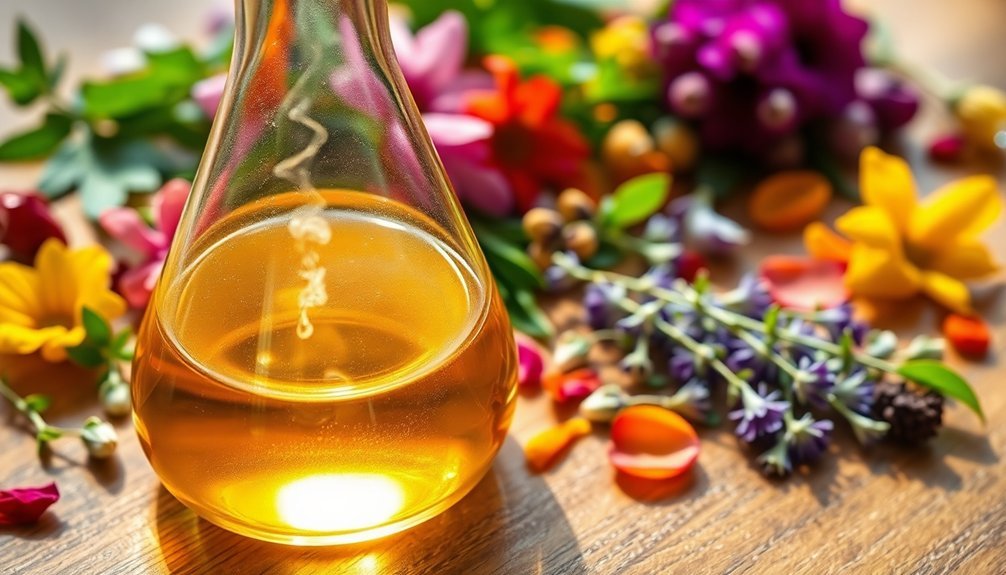
While many fragrance extraction methods exist, solvent extraction stands as a cornerstone technique in natural perfumery.
You'll find this process particularly useful when working with delicate plant materials that contain low concentrations of essential oils or components that heat could damage.
The basic process involves submerging your raw materials in a solvent, which dissolves the aromatic compounds. Common solvents like hexane and dimethyl ether are typically employed in this extraction method.
This mixture then undergoes careful processing to remove the solvent, typically through vacuum processing or low-temperature distillation.
What you're left with is called a concrete – a mixture containing essential oils, waxes, and resins.
Since this concrete is often too thick or solid to use directly, it requires further refinement with alcohol to create an absolute, which is the concentrated fragrant extract you'll use in perfumery.
Common Solvents Used in Natural Perfumery
When you're working with organic solvents in natural perfumery, you'll need to follow strict safety protocols to protect yourself from harmful vapors and skin contact.
You can achieve the purest extractions using alcohol-based methods, which offer better control and fewer residual chemicals compared to petroleum-based alternatives. Understanding the difference between polar and non-polar solvents is crucial for successful extraction techniques.
While natural oils extracted through these processes tend to be more expensive than their synthetic counterparts, they provide more complex and authentic aromatic profiles that many perfumers prefer.
Organic Solvent Safety Practices
Although natural perfumery relies on various extraction methods, understanding common organic solvents and their safe handling is essential for successful fragrance creation.
You'll encounter solvents like acetone, ethyl acetate, isopropyl myristate, and CO2 in your perfumery journey. Each solvent serves specific purposes, from extracting essential oils to binding fragrances. Alcohol as solvent helps carry and blend various aromatic ingredients effectively.
When working with these solvents, you'll need to prioritize safety and proper handling techniques to protect yourself and maintain product quality.
- Always work in a well-ventilated area to prevent inhaling volatile fumes
- Wear protective gear including gloves, goggles, and appropriate clothing
- Store solvents away from heat sources and open flames
- Keep solvents in properly labeled containers to avoid confusion
- Maintain a clean workspace and handle one solvent at a time to prevent cross-contamination
Essential Alcohol-Based Extractions
Anyone interested in natural perfumery should start with alcohol-based extractions, as they form the foundation of traditional fragrance creation.
Ethanol, derived from corn, grapes, or sugar cane, is the most versatile solvent you'll encounter. It's highly compatible with most substances and excels at distributing delicate fragrance notes.
You'll find the maceration method particularly useful for extracting aromas from semi-dried flowers. Simply place your flowers in a glass container, cover them with ethanol, and store in a cool, dark place for several weeks.
You can speed up this process using an ultra-sonic bath, keeping temperatures below 30°C.
What makes alcohol so effective is its ability to dissolve essential oils while preserving their integrity. It's especially suitable for extracting compounds from delicate flowers like rose, jasmine, and tuberose.
Natural Oils Vs Synthetics
Four key extraction methods dominate natural perfumery: steam distillation, solvent extraction, expression, and hydrosol production.
When working with these methods, you'll need to choose between various solvents, each offering unique benefits for extracting natural oils.
CO2 extraction stands out as an eco-friendly option that preserves delicate fragrances, while ethyl acetate provides a cost-effective solution for cosmetic applications.
IPM serves as an excellent alternative in non-alcoholic perfumes, and water remains the versatile foundation for many fragrance formulations.
- CO2 extraction preserves fragrance compounds through low-temperature processing
- Ethyl acetate's rapid evaporation makes it ideal for light, fruity scents
- IPM works well as a binder in oil-based perfumes
- Water-based solutions create soft, natural fragrances
- Hydrosols offer subtle alternatives to concentrated essential oils
The Step-by-Step Extraction Process
You'll start by washing the prepared plant materials with primary solvents like hexane or pentane, allowing thorough penetration into the fragile botanical matter.
Next, you filter the solvent mixture and remove excess liquid through vacuum distillation to create a waxy substance called a concrete.
Finally, you'll treat the concrete with ethyl alcohol to selectively extract the fragrant compounds, followed by a second distillation to produce the pure absolute with minimal solvent residue.
Primary Solvent Application Phase
The extraction of natural perfumes through solvents begins with careful plant material preparation, followed by strategic solvent application.
You'll find this process particularly effective for delicate flowers and materials with low essential oil content. The solvents you'll use, such as hexane, pentane, or ethanol, are chosen specifically to minimize alterations while maximizing fragrance extraction.
- Place your plant materials in shallow trays for ideal solvent coverage
- Break down larger materials or use rotating drums to guarantee thorough penetration
- Apply your chosen solvent directly to the prepared plant material
- Let the solvent work to dissolve the fragrant compounds completely
- Filter the mixture to separate the plant material from your solvent solution
This critical phase sets the foundation for the entire extraction process, determining the quality and yield of your final absolute.
Concrete Formation and Filtering
Following your solvent application, concrete formation marks the next major phase in natural perfume extraction. As the solvent dissolves fragrant compounds from your plant materials, you'll need to evaporate it under vacuum conditions. This process leaves behind a semi-solid, waxy mass known as concrete.
Your concrete will contain essential oils, waxes, resins, and other oil-soluble compounds from the plant material. You'll notice it's typically pale yellow or whitish-opaque, with a concentrated fragrance.
To purify this concrete, you'll need to wash it with alcohol and perform cold filtration to remove unwanted substances. This vital step prepares your concrete for further processing into absolutes, which are essential for perfume production.
The recovered solvent isn't wasted – you can recycle it for future extractions.
Absolute Separation and Refinement
Mastering absolute separation requires precise solvent selection and careful refinement techniques.
You'll need to treat your concrete with ethanol to isolate the aromatic compounds from other components. During this process, the absolute dissolves in the alcohol while unwanted lipids remain behind.
Through vacuum distillation, you'll remove excess solvent, leaving you with a pure, concentrated absolute that contains just 1-5% residual solvent.
- Choose your solvent carefully – hexane and pentane work well for initial extraction
- Apply ethanol in the second phase to separate the absolute from other components
- Monitor temperature closely to preserve delicate aromatic compounds
- Filter thoroughly to guarantee clarity and purity
- Remove excess solvent through careful vacuum distillation
The resulting absolute will be thicker and richer than essential oils, with an intense fragrance that closely matches the original plant material.
From Plant Material to Concrete Formation
Successfully creating natural perfume extracts begins with selecting appropriate plant materials and applying precise solvent extraction techniques. You'll find that delicate flowers like jasmine and rose, along with woody materials, are commonly used. The process involves submerging these materials in carefully chosen solvents like hexane or ethanol, which effectively dissolve the aromatic compounds.
| Material Type | Common Examples | Best Solvent Choice |
|---|---|---|
| Delicate Flowers | Jasmine, Rose | Hexane |
| Woody Materials | Bark, Roots | Ethanol |
| Animal Sources | Ambergris, Musk | Dimethyl Ether |
| Fibrous Plants | Leaves, Stems | Hexane/Ethanol Mix |
When you've completed the extraction, you'll remove the solvent through vacuum processing or low-temperature distillation. The result is a semi-solid concrete that contains concentrated fragrant compounds, waxes, and resins, typically appearing pale yellow or light beige.
Converting Concretes Into Pure Absolutes
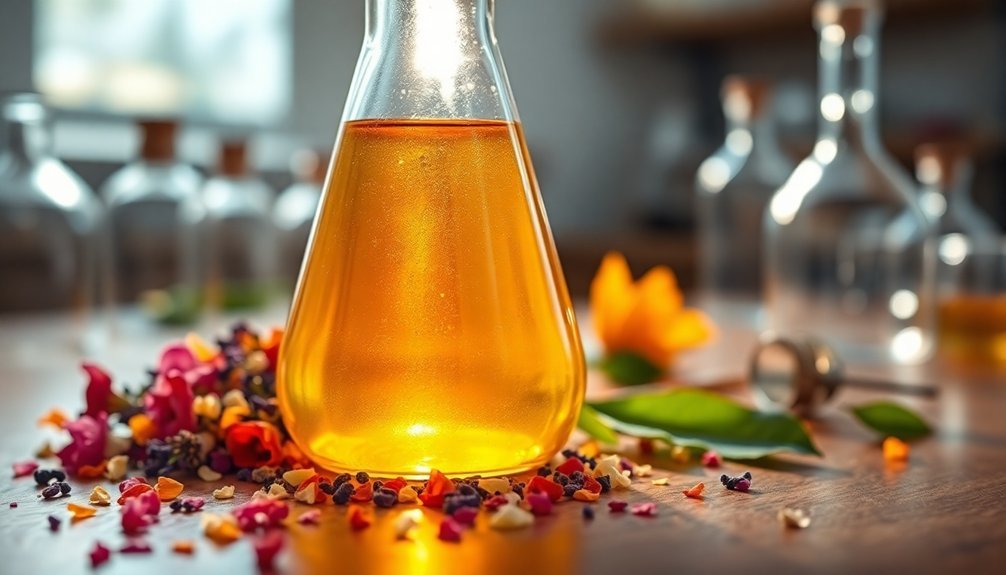
Once you've obtained the concrete, the next step is transforming it into a pure absolute through a refined secondary extraction.
You'll use ethyl alcohol or another suitable alcohol as your secondary solvent to dissolve only the fragrant compounds. After dissolving the concrete in alcohol, you'll filter the mixture to separate the aromatic components from unwanted waxes and resins.
The final step involves vacuum distillation to remove the alcohol, leaving you with a concentrated absolute containing just 1-5% residual solvent.
- Rich, authentic fragrance that's true to the original plant material
- Higher concentration than essential oils
- Perfect for delicate raw materials that can't withstand steam distillation
- Exceptional longevity and strength in perfume applications
- Superior quality suitable for luxury perfumery
Essential Safety Measures for Home Extraction
Before attempting any solvent extraction at home, you'll need to implement thorough safety measures to protect yourself and your workspace.
You must equip yourself with proper PPE, including chemical-resistant gloves, safety goggles, and a protective mask. Don't forget to wear closed-toe shoes and a lab coat to minimize skin exposure.
Set up your extraction area in a well-ventilated space, away from any heat sources or ignition points. Keep fire extinguishers and spill response kits within easy reach.
You'll need to store your solvents in approved, clearly labeled containers and maintain strict disposal protocols. Make sure you understand local regulations regarding solvent use and keep detailed safety records.
Regular equipment maintenance and safety checks are essential to prevent accidents. Never skip safety protocols, even for small-scale extractions.
Best Plants for Solvent Extraction Methods
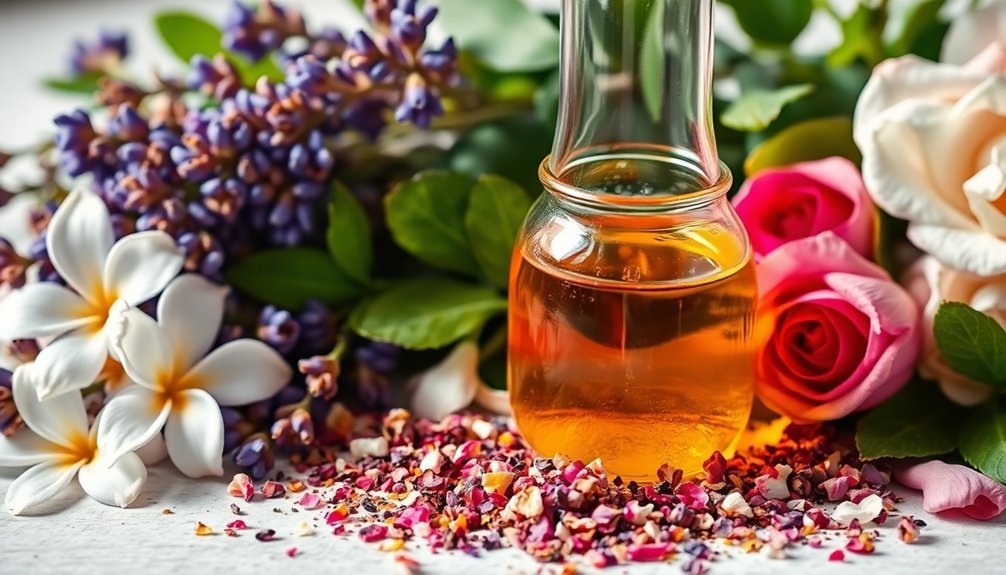
When you're working with solvent extraction for natural perfumes, you'll find that delicate flowers like jasmine and rose require gentle handling with cold solvents to preserve their complex fragrances.
Your temperature-sensitive plants, including orange blossom and tuberose, need careful monitoring during extraction to prevent heat damage to their essential compounds.
For resinous materials, you'll want to use ethanol-based solvents at controlled temperatures to effectively extract their aromatic properties while maintaining the integrity of their natural compounds.
Delicate Flower Processing Methods
Delicate flowers like jasmine, rose, and tuberose present unique challenges in natural perfume production, making solvent extraction the preferred method for capturing their essence.
You'll find that these fragile blooms require gentle processing to preserve their complex aromatic compounds, which could be damaged by traditional steam distillation methods.
- Place fresh flower petals in shallow trays for ideal solvent coverage
- Wash the petals with carefully selected solvents like hexane or ethanol
- Filter the mixture to separate plant material from the aromatic solution
- Concentrate the filtered solution to create a concrete
- Process the concrete with alcohol to produce a pure absolute
This careful handling guarantees you'll capture the true essence of heat-sensitive flowers while maintaining their rich, authentic fragrances.
The method's particularly effective for flowers with low oil content or those that can't withstand high temperatures.
Temperature-Sensitive Plant Selection
Selecting the right plants for solvent extraction is essential since not all flowers can withstand traditional distillation methods. You'll find that jasmine, rose, tuberose, orange blossom, and violet are ideal candidates due to their delicate nature and complex fragrance compounds.
When you're working with these temperature-sensitive flowers, you'll benefit from solvent extraction's ability to preserve their intricate scent profiles. This method offers high yields and minimal damage to the flower material, ensuring you capture the most authentic fragrances.
While steam distillation might damage these delicate blooms, solvent extraction lets you selectively extract specific aromatic compounds.
Keep in mind that you'll need to take into account the trade-offs, including potential residual solvents and higher costs. However, the superior quality and consistency of the final product often justify these limitations.
Resinous Material Extraction Steps
Although solvent extraction excels with delicate flowers, it's not typically the go-to method for resinous materials.
You'll find that delicate flowers like jasmine, rose, and tuberose are perfect candidates for solvent extraction using either hexane or ethanol as the primary solvent.
While labdanum can be processed through solvent extraction, most hard resins like frankincense and myrrh require different approaches, such as tapping or steam distillation.
- Orange blossom petals yield their fragrant compounds readily to hexane
- Fresh mimosa flowers preserve their delicate scent through solvent extraction
- Violet's complex aroma stays intact when processed with careful solvent selection
- Jasmine absolute retains its full bouquet through hexane extraction
- Tuberose maintains its rich, creamy notes when extracted with solvents
Equipment and Tools Required

Successful solvent extraction requires an extensive set of specialized equipment and tools. You'll need extractors and solvent containers for the main process, along with filters and evaporation equipment to separate and concentrate the extracts. Don't forget essential safety gear like gloves and protective equipment when handling solvents.
| Equipment Type | Purpose | Examples |
|---|---|---|
| Primary Tools | Material Processing | Sieves, Scales, Wooden Boards |
| Extraction Gear | Main Process | Extractors, Filters, Evaporators |
| Post-Processing | Refinement | Centrifuges, Distillation Units |
For post-extraction, you'll need centrifuges and distillation apparatus to purify your products. Quality control tools like spectrophotometers help guarantee your extracts meet standards. Store your finished products in appropriate containers designed for essential oils and absolutes.
Comparing Different Extraction Methods
When choosing a perfume extraction method, you'll need to evaluate factors like the raw material's delicacy, desired end product, and available equipment.
Each technique offers distinct advantages and limitations that'll affect your final fragrance.
- Steam distillation works best for hardy plants with high oil content, but it can damage heat-sensitive compounds.
- Solvent extraction using hexane or ethanol produces potent concretes that you'll need to further process into absolutes.
- CO2 extraction preserves delicate aromas and leaves no residue, though you'll need specialized high-pressure equipment.
- Enfleurage captures the true essence of delicate flowers but requires considerable time and expense.
- Traditional solvent methods offer a good balance of accessibility and quality for most perfume makers.
Remember that your choice will considerably impact the authenticity, complexity, and quality of your final fragrance.
Proper Storage of Solvent-Extracted Materials

Proper storage of solvent-extracted materials directly impacts the longevity and quality of your natural perfumes.
You'll need to store your extracts in dark, airtight glass containers to prevent degradation from light exposure and oxidation. Keep them in a cool, well-ventilated area away from heat sources and flammable materials.
When handling these materials, always wear protective gear like gloves to avoid skin contact.
You'll want to maintain consistent temperature and humidity levels in your storage area, and regularly check for signs of degradation. If needed, use preservatives or stabilizers to maintain quality over time.
Don't forget to label and date your containers for proper tracking. Clean and dry containers thoroughly before use to prevent contamination and guarantee the purity of your extracts.
Troubleshooting Common Extraction Issues
Understanding common extraction issues can help you avoid costly mistakes and guarantee consistent results.
You'll need to watch for residual solvents, which often reveal themselves through a petroleum-like smell. Quality control is essential, as variations in solvent quality and extraction conditions can affect your final product's scent profile and purity.
To maintain regulatory compliance and assure safety, you'll want to implement rigorous purification steps.
- Monitor solvent residue levels – they should never exceed 1 part per million
- Check for any alterations in the natural scent of your extracted oil
- Watch extraction time and temperature to prevent degradation of fragrance compounds
- Test for consistency in oil yield and chemical composition
- Verify purification steps are effectively removing all traces of solvents
Creating Your First Solvent-Extracted Perfume
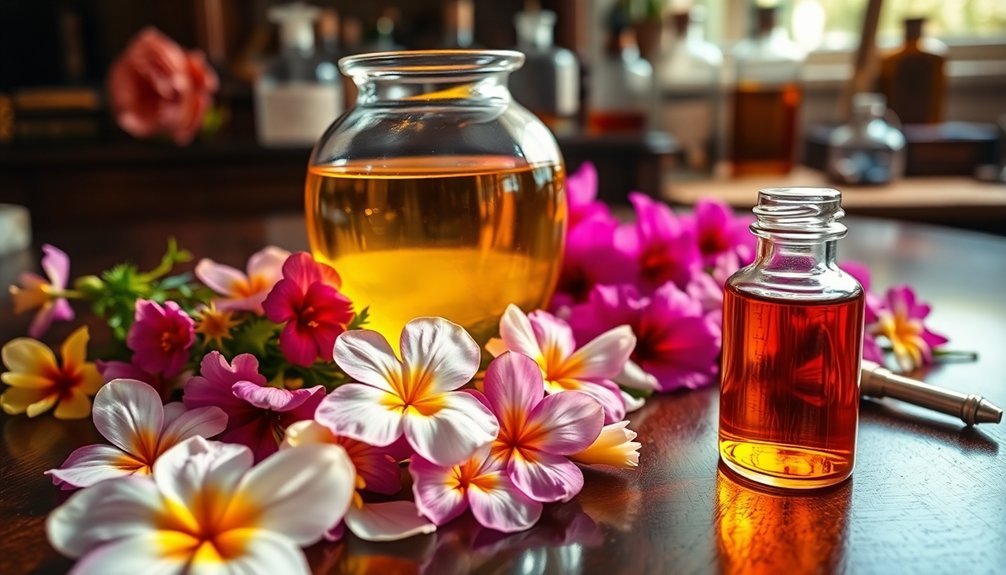
Creating your first solvent-extracted perfume requires careful attention to both equipment and ingredients. You'll need to select food-grade solvents like hexane, pentane, or ethanol that can effectively dissolve fragrant compounds without damaging your plant materials.
Start by preparing your plant materials in a shallow tray, breaking them up if necessary to guarantee even solvent penetration. If you're working with delicate flowers like jasmine or vanilla, you'll need to handle them with extra care.
Wash your materials thoroughly with your chosen solvent, then filter the mixture and use vacuum distillation to remove excess solvent.
To produce the absolute, you'll treat the resulting concrete with ethanol to separate the aromatic compounds from other components. After a final vacuum distillation, you'll have your pure absolute with minimal solvent content remaining.
Frequently Asked Questions
How Long Do Solvent-Extracted Perfumes Typically Last on Skin?
You'll find solvent-extracted perfumes typically last 6-8 hours on your skin, but duration varies based on your skin's chemistry, moisture levels, and environmental factors like temperature and humidity around you.
Can Solvent-Extracted Perfumes Trigger Allergic Reactions More Than Other Extraction Methods?
Yes, you're more likely to experience allergic reactions with solvent-extracted perfumes due to residual chemicals and complex compounds. Steam distillation and CO2 extraction typically pose lower allergy risks due to their solvent-free nature.
Why Are Some Solvent-Extracted Perfumes Significantly More Expensive Than Others?
You'll find pricier solvent-extracted perfumes often use rarer ingredients, require longer processing times, and come from prestigious brands with expert perfumers. Higher quality source materials also greatly impact the final cost.
Does the Season of Plant Harvesting Affect the Quality of Solvent Extraction?
Yes, the season when you harvest plants greatly affects extraction quality. You'll get the best results during peak blooming periods when the plant's essential oils are most concentrated and abundant in their tissues.
Can Solvent-Extracted Perfumes Be Mixed With Traditional Essential Oils?
Yes, you can mix solvent-extracted perfumes with essential oils. You'll want to dilute your absolutes first, then carefully blend them with essential oils to create unique fragrances while considering their different concentrations.
In Summary
Now you've learned the art of solvent extraction for natural perfumes. You'll find it's a delicate process that requires patience and precision, but the results are worth the effort. Whether you're using ethanol, hexane, or other solvents, you can create exquisite absolutes from plant materials. Remember to maintain proper safety protocols and storage conditions to preserve your precious extracts for your perfume creations.

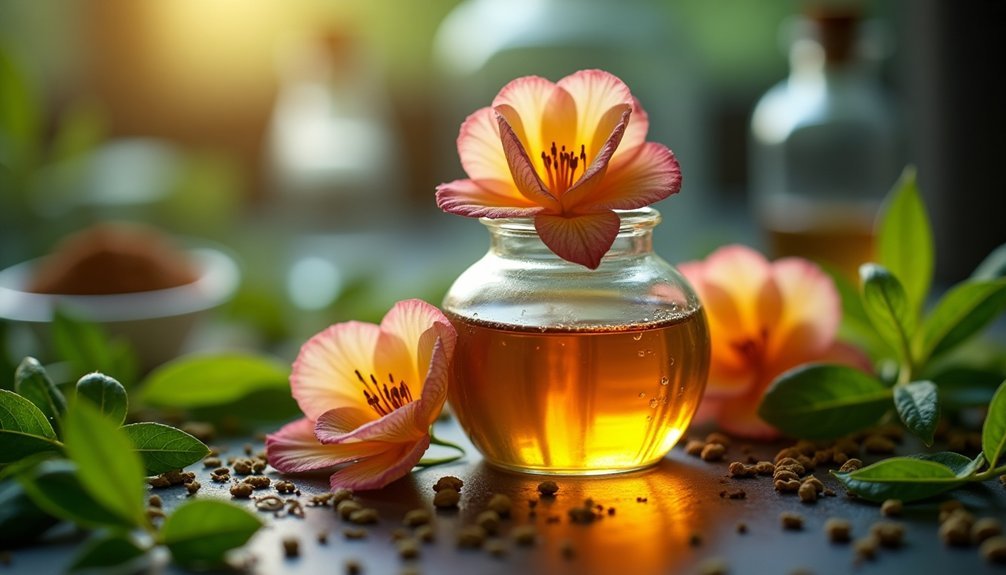
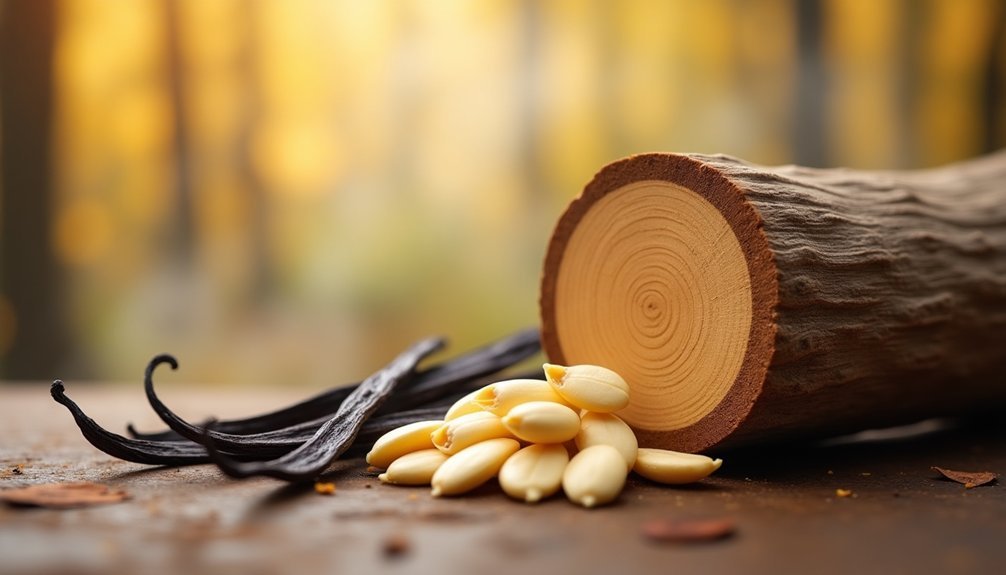
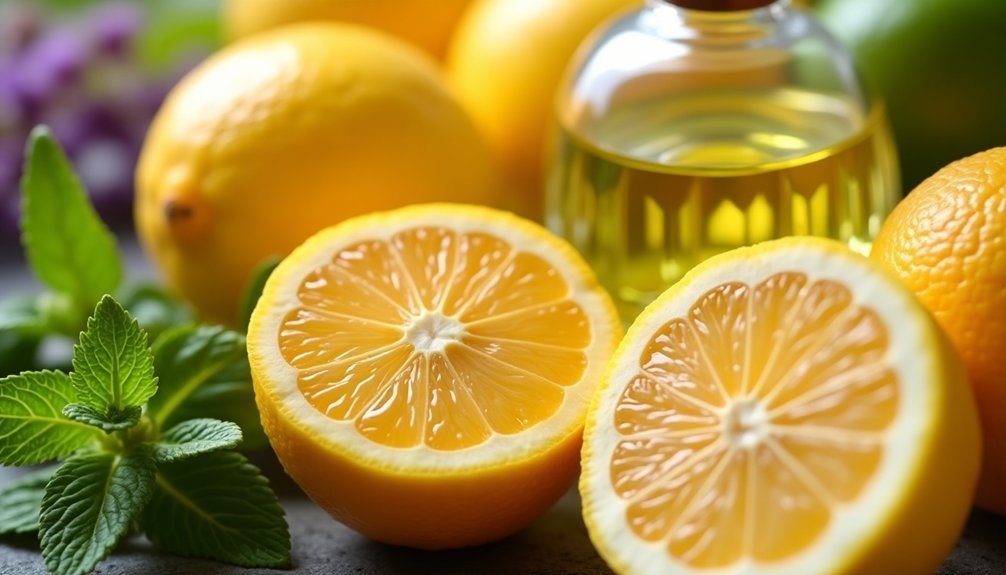
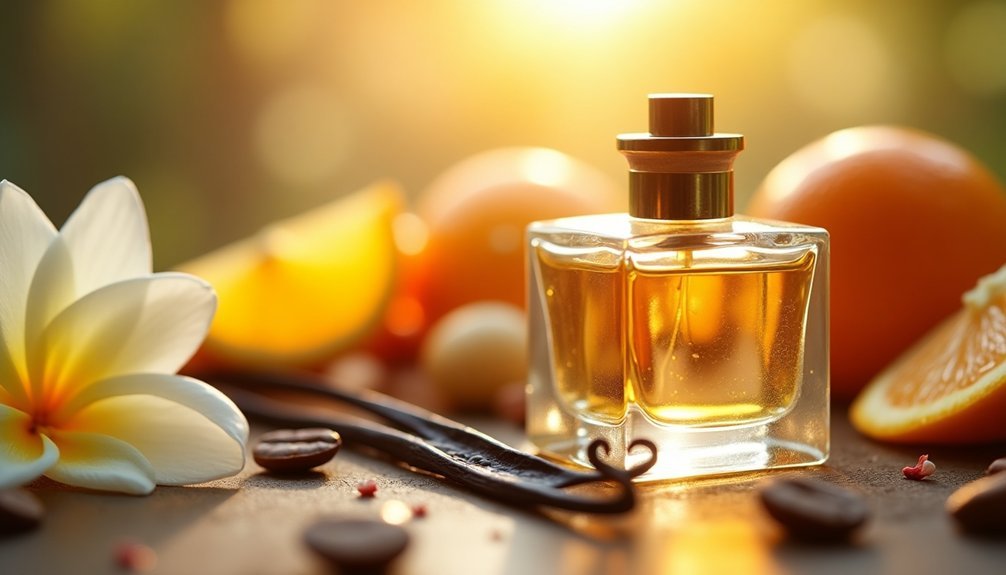
Leave a Reply